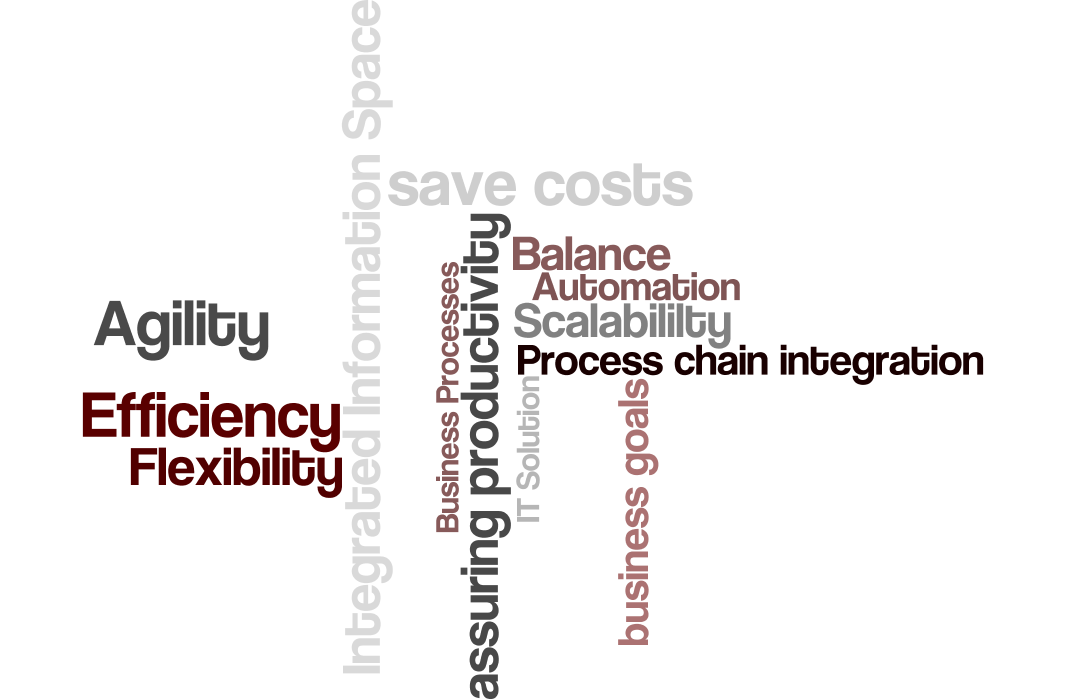Agile Processes need flexible integration solutions;
high-grade and well-balanced results need considering the Big Picture, preferable combined with iterative working methods.




through flexible Integration Solutions
Agile Processes need flexible integration solutions;
high-grade and well-balanced results need considering the Big Picture, preferable combined with iterative working methods.
 Process Chain Integration
Process Chain Integration
When applying a solution of this kind, the benefits result from multiple effects.
Ceasing manual data transfers between software applications saves time and eliminates errors.
This holds also true for the automation of selected tasks:
Less time and less errors.
Staff members browse directly in the up-to-date data of the other prozess steps and are thus working within the "Big Picture", within the integrierted information space. They get Feedback for their own solutions by colleagues. Combined with a cyclic-iterative way of work, well-balanced solutions result, requiring less time while less errors are made.
The software applications are also acting within the information space, identifying needed data and informations at runtime. If new solutions occur to be used in the product, only the domain meta model will be amended. The flexible integration solutions assures that they will be instantly applied without the need for changing software applications.
The software applications used in each process step can be chosen freely and exchanged at any time, so that the best of class solutions or the ones offering the best cost-benefit ratio can be used, respectively. This fosters productivity and/or reduces costs for software licenses and maintenance. When an application is being substituted, the other applications will continue funtioning properly and do not have to be touched.
For concretisation, we consider a simplified process chain comprising only three individual activities , the process steps PS1, PS2 and PS3, in each of which exactly one software application is used.
PS2 needs some input data from PS1 before it is able to start off. They shall be read, interpreted and converted into PS2's own format. This is common and well-justified redundancy. So, PS2 needs also some information about how the input data can be accessed and converted (n:m mapping). The software application SA2, which is used in PS2, cared for all described issues.
SA2 retrieves the control information needed from the domain meta model. It subsequently reads the data by executing a service call without interaction with the user. The applied automation saves time and avoids errors. Source and destination information are correlated (cross-linked) to each other. Now, the gap between the process steps and their applications is closed; context has been created, the integrated information space has grown, data turn into information . This is a mandatory prerequisite for providing the user with the Big Picture and for the desired cyclic-iterative way of working.
Please note: Compared to the conventional solution, orientation- and direction-providing retrieval steps have been introduced and slotted in: the applications check which relevant information exists and consume the appropriate selection afterwards, only. This approach significantly improves the quality of co-operation of the process steps and yields especially well-balances results.
Now, the users starts working in PS2 and is creating new content.
The next Iteration Step.
Subsequently, the process chain is executed for the second time. Again, PS1 starts off. However, before the respective staff member changes and details his/her data, he/she browses the already existing results of the subsequent process steps. For instance, PS3 could have performed an evaluation/simulation of the PS1 solutions from a certain view point. Therefore, PS1 will now adjust his/her further work according to PS3's results. The solution will become better balanced as it takes into account the concerns of the rest of the process chain early and continuously.
At the beginning of PS2's second run, the respective staff member browses PS1's changed data. He/she notices that the data have been amended by explanatory comments. This information influences his/her further work, and again, the results will get better-balanced. So, also while the PS2 expert is working, he/she is also aware of the overall process and gets informed about new circumstances before continuing the work.
This iterative cycle is repeated until the desired results are obtained at the desired level of quality.
The product portfolio is to be changed.
Let us now assume, the company extends its product by new features. For this purpose it introduces some new technology. As to the IT, this measure will be realized by extending the domain meta model. The new information contents will arrive at the software applications via the described model-controlled integration; for example, in form of new building blocks available for the product design. But also the meta descriptions of the automation steps will be expanded in order to take account of the new object types.
As a result, there will be some new types of objects and relations in the data of application A1. A2 retrieves this extended information as described above and applies appropriate automation steps – without having had to change any interfaces or software. The agile process is designed for its ability to tackle changes – in other words, it is coded for flexibility; it is controllable, changeable and thus easily adaptable to current requirements.
Are you interested in more details? Don't hesitate to contact us! We are looking forward to getting to know you.
